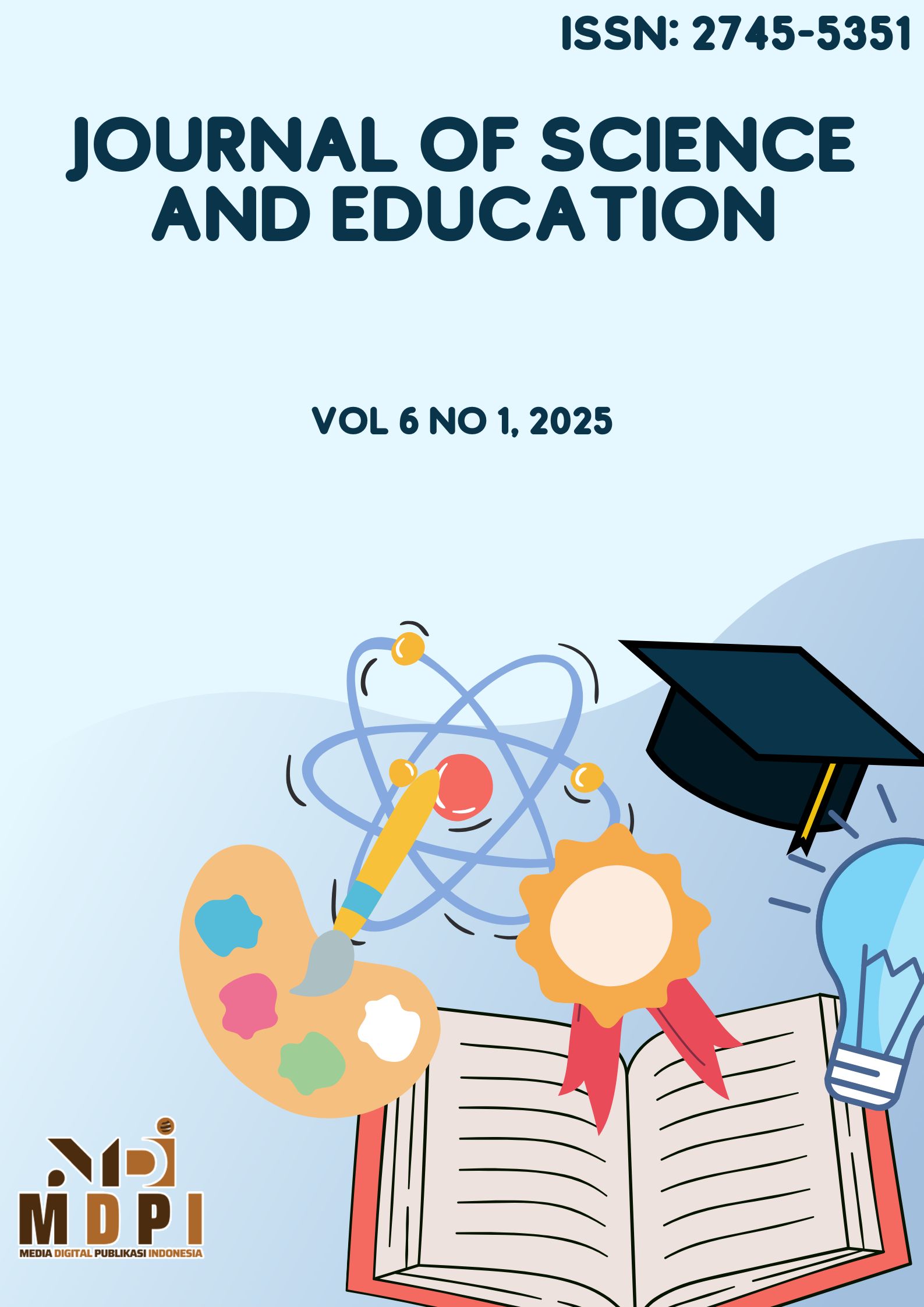Analysis and Exploration of Hypermedia-Based Learning Materials Proyek IPAS in Grade 10 Vocational High School
DOI:
https://doi.org/10.58905/jse.v6i1.543Keywords:
Learning material, Projek IPAS, Vocational High School, HypermediaAbstract
One of the innovations arising from technological developments is using hypermedia in learning. Therefore, this study aims to identify learning needs in the development of hypermedia-based Proyek IPAS learning materials in Class X vocational schools. The research method used is Research and Development (R&D), the development model used in this study combines the Dick and Carey and Lee & Owens models, which focus on the development of hypermedia-based Proyek IPAS learning materials, both of which were chosen because they complement each other in the development of technology-based learning materials, especially in multimedia learning such as hypermedia. Data collection techniques used observation, questionnaire interviews, and learning outcomes tests. The results showed that students aged 15-16 can use technological devices such as laptops, tablets, and smartphones, but are more often used for entertainment than learning. Observations revealed the limitations of available learning materials, so interactive and appropriate hypermedia-based Proyek IPAS learning materials are needed. This research provides a basis for developing innovative and relevant hypermedia-based Proyek IPAS learning materials to support project-based learning in vocational high schools.
Downloads
References
S. B. Dito and H. Pujiastuti, “Dampak Revolusi Industri 4.0 Pada Sektor Pendidikan: Kajian Literatur Mengenai Digital Learning Pada Pendidikan Dasar dan Menengah,” Jurnal Sains dan Edukasi Sains, vol. 4, no. 2, pp. 59–65, 2021, doi: 10.24246/juses.v4i2p59-65.
A. Feri and Z. Zulherman, “Analisis Kebutuhan Pengembangan Media Pembelajaran IPA Berbasis Nearpod,” Jurnal Imiah Pendidikan dan Pembelajaran, vol. 5, no. 3, p. 418, Aug. 2021, doi: 10.23887/jipp.v5i3.33127.
F. E. Nastiti and A. R. N. ‘Abdu, “Kesiapan Pendidikan Indonesia Menghadapi era society 5.0,” Kajian Teknologi Pendidikan, vol. 5, no. 1, pp. 61–66, 2020.
M. Djannah, Zulherman, and Nurafni, “Kahoot Application for Elementary School Students: Implementations of Learning Process from Distance during Pandemic period of COVID 19,” J Phys Conf Ser, vol. 1783, no. 1, 2021, doi: 10.1088/1742-6596/1783/1/012121.
M. S. Pratiwi, Zulherman, and G. Amirullah, “The Use of the Powtoon Application in Learning Videos for Elementary School Students,” J Phys Conf Ser, vol. 1783, no. 1, 2021, doi: 10.1088/1742-6596/1783/1/012115.
R. Andrianingsih and D. Mustika, “Pemanfaatan Internet sebagai Sumber Belajar Siswa di Kelas Rendah Sekolah Dasar,” Jurnal Obsesi : Jurnal Pendidikan Anak Usia Dini, vol. 6, no. 6, pp. 6164–6172, 2022, doi: 10.31004/obsesi.v6i6.3388.
S. Ningsih, D. V. Sigit, and E. Lisanti, “Development of multimedia based teaching materials to increase cognitive learning outcomes in respiration systems,” International Journal of Engineering Technologies and Management Research, vol. 6, no. 7, pp. 34–45, Mar. 2020, doi: 10.29121/ijetmr.v6.i7.2019.413.
R. Yao, G. Zhang, Y. Wang, and R. Bie, “Design of Teaching Material Evaluation Incentive Mechanism based on Game Theory,” in Procedia Computer Science, Elsevier B.V., 2022, pp. 47–54. doi: 10.1016/j.procs.2022.04.007.
M. C. S. Manzanares, M. D. C. E. Llamazares, and Á. A. González, “Effectiveness of blended learning in nursing education,” Int J Environ Res Public Health, vol. 17, no. 5, 2020, doi: 10.3390/ijerph17051589.
A. O. Ajlouni and S. A. Jaradat, “The effect of pedagogical hypermedia on acquisition of scientific concepts among primary school students,” International Journal of Education and Practice, vol. 8, no. 3, pp. 615–624, 2020, doi: 10.18488/journal.61.2020.83.615.624.
R. T. Maun, P. V. Togas, and S. Pratasik, “Aplikasi Multimedia Pembelajaran Proyek IPAS di SMK Kristen 3 Tomohon,” Edutik : Jurnal Pendidikan Teknologi Informasi dan Komunikasi, vol. 2, no. 3, pp. 438–448, 2022, doi: 10.53682/edutik.v2i3.5347.
E. R. Ririn, A. Salimi, and D. A. V. Ghasya, “Pengembangan Media Pembelajaran Interaktif Berbasis Smart Apps Creator Mata Pelajaran IPAS Kelas IV SDN 14 Pontianak Selatan,” As-Sabiqun, vol. 6, no. 1, pp. 178–189, 2024, doi: 10.36088/assabiqun.v6i1.4378.
E. R. Novianti and Hardeli, “Development of IPAS on Matter and its Changes Based on PjBL to Improve the Science Process Skills for Grade E Vocational High School,” Jurnal Penelitian Pendidikan IPA, vol. 10, no. 7, pp. 4066–4074, 2024, doi: 10.29303/jppipa.v10i7.7801.
Badan Standar Kurikulum dan Asesmen Pendidikan, “Keputusan Kepala Badan Standar, Kurikulum, dan Asesmen Pendidikan Kementerian Pendidikan, Kebudayaan, Riset, dan Teknologi Nomor 008/H/KR/2022 Tentang Capaian Pembelajaran Pada Pendidikan Anak Usia Dini, Jenjang Pendidikan Dasar, dan Jenjang Pendidikan Me,” 2022. [Online]. Available: https://kurikulum.kemdikbud.go.id/wp-content/unduhan/CP_2022.pdf
K. Afifa and T. Astuti, “The Effect of Digital Learning Media on Motivation and Learning Outcomes of IPAS,” Jurnal Penelitian Pendidikan IPA, vol. 10, no. 6, pp. 3155–3165, 2024, doi: 10.29303/jppipa.v10i6.7513.
A. Jaafar, M. Murniyati, G. Kurniawan, D. Darwati, and G. Radila, “Improving the Quality of Teacher Learning Using Multimedia Through Workshop Activities in Schools,” International Journal of Elementary School, vol. 1, no. 1, pp. 8–13, 2024, doi: 10.69637/ijes.v1i1.25.
T. Rahmanto and I. Wilujeng, “Development of Student Worksheets Using the Engineering Design Process to Practice Physics Problem-Solving Skills for Vocational School Students,” Jurnal Penelitian Pendidikan IPA, vol. 10, no. 2, pp. 545–556, 2024, doi: 10.29303/jppipa.v10i2.4969.
I. K. W. B. Wijaya, I. M. W. Yasa, and N. M. Muliani, “Menumbuhkan Literasi Sains Siswa Sekolah Dasar di Lingkungan Keluarga,” Jurnal Pendidikan MIPA, vol. 13, no. 4, pp. 1012–1016, 2023, doi: 10.37630/jpm.v13i4.1259.
Darmaji, Astalini, E. Nursulistiyo, D. A. Kurniawan, S. M. Husna, and R. Perdana, “The Relationship Between Digital Literacy and Students’ Science Process Skills in Junior High Schools,” Journal of Education Research and Evaluation, vol. 7, no. 4, pp. 703–712, 2023, doi: 10.23887/jere.v7i4.58388.
M. Afifulloh and B. Cahyanto, “Analisis Kebutuhan Pengembangan Bahan Ajar Elektronik Di Era Pandemi Covid-19,” JPDI (Jurnal Pendidikan Dasar Indonesia), vol. 6, no. 2, p. 31, 2021, doi: 10.26737/jpdi.v6i2.2515.
B. D. Amin, A. Haris, and A. Swandi, “Implementation of Physics Learning Based on Hypermedia To Enhance Student’S Problem Solving Skill,” International Journal of Teaching & Education, vol. VII, no. 2, pp. 1–11, 2019, doi: 10.20472/te.2019.7.2.001.
M. K. Anam, I. Mudakir, and J. Prihatin, “The Development of Hypermedia-Based E-Module to Enhance Students’ Creative Thinking Skills in the Topic of Digestive System for Junior High School Students …,” Bioedukasi, vol. 21, no. 3, pp. 256–262, 2023, doi: 10.19184/bioedu.v21i3.40941.
L. S. del Río, C. V. Sanz, and N. D. Búcari, “Incidence of a hypermedia educational material on the teaching and learning of mathematics,” Journal of New Approaches in Educational Research, vol. 8, no. 1, pp. 50–57, Jan. 2019, doi: 10.7821/naer.2019.1.334.
M. Karumiadri, M. Jinan, and M. N. R. Maksum, “Nilai-Nilai Pendidikan Humanistik Menurut Prof. Dr. Hamka serta Relevansinya terhadap Tujuan Pendidikan Nasional,” Murhum : Jurnal Pendidikan Anak Usia Dini, vol. 4, no. 2, pp. 165–178, 2023, doi: 10.37985/murhum.v4i2.170.
W. Dick, L. Carey, and J. O. Carey, The Systematic Design of Instruction, Eight Edit. USA: Pearson, 2015.
W. W. Lee and D. L. Owens, Multimedia-based instructional design. USA: Pfeiffer, 2004.
Y. Wei, Q. Qin, C. Chen, and X. Liu, “Research on the Construction and Application of Knowledge Graph of Digital Resources in Vocational Colleges,” J Comput (Taipei), vol. 34, no. 4, pp. 195–201, 2023, doi: 10.53106/199115992023083404017.
B. U. Wutsqo, D. M. Rizky, and D. R. Hidayat, “Hubungan Konsep Diri dengan Kematangan Vokasional Pada Siswa SMK,” Jurnal Ilmiah Bimbingan Konseling Undiksha, vol. 11, no. 1, pp. 54–60, 2020, doi: 10.23887/jjbk.v11i1.27391.
M. Alenezi, S. Wardat, and M. Akour, “The Need of Integrating Digital Education in Higher Education : Challenges and Opportunities,” pp. 1–12, 2023, doi: 10.3390/su15064782.
F. R. Andardi et al., “Pendampingan Perencanaan Dan Rehabilitasi Sd Muhammadiyah 5 Sukun Malang,” Abdimas Galuh, vol. 5, no. 1, p. 329, 2023, doi: 10.25157/ag.v5i1.9505.
Awaludin, B. Wibawa, and M. Winarsih, “The development of hypermedia based e-book for integral calculus subject,” International journal of online and biomedical engineering, vol. 16, no. 4, pp. 109–127, 2020, doi: 10.3991/ijoe.v16i04.13393.
M. C. Sáiz-Manzanares, R. Marticorena-Sánchez, J. F. Díez-Pastor, and C. I. García-Osorio, “Does the use of learning management systems with hypermedia mean improved student learning outcomes?,” Front Psychol, vol. 10, no. FEB, pp. 1–14, 2019, doi: 10.3389/fpsyg.2019.00088.
H. Haryanto, H. R. Widarti, A. Mashfufah, R. S. I. Dewi, and S. R. Kusumaningrum, “Flipbook-Based Project-Based Learning: An Opportunity to Improve Science Literacy,” Jurnal Penelitian Pendidikan IPA, vol. 10, no. 7, pp. 4004–4009, 2023, doi: 10.29303/jppipa.v10i7.7916.
Downloads
Published
How to Cite
Issue
Section
License
Copyright (c) 2025 Auliya Naimah, Robinson Situmorang, Dwi Kusumawardani

This work is licensed under a Creative Commons Attribution-ShareAlike 4.0 International License.

















